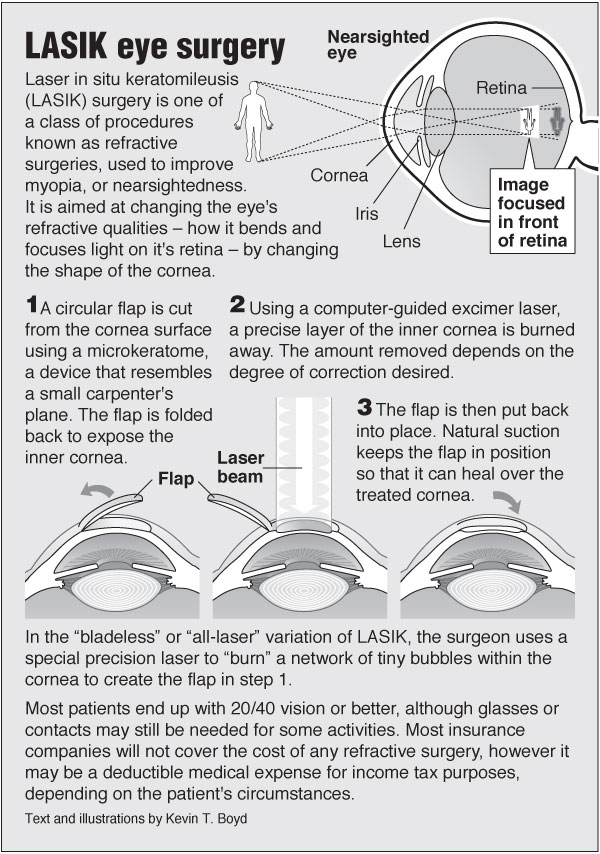Interested In Finding Out About The Differences Among SMILE, LASIK, And PRK Treatments For The Eyes?
Interested In Finding Out About The Differences Among SMILE, LASIK, And PRK Treatments For The Eyes?
Blog Article
Composed By-Adler Osborne
If you've been thinking about SMILE eye surgical procedure, you could question exactly how it compares to LASIK and PRK. Each treatment has its very own collection of advantages and considerations. From quicker recuperation times to potential dangers, there are vital differences you must recognize before choosing. Recognizing these distinctions will aid you make an enlightened selection that lines up with your details demands and expectations. Curious to understand more regarding how these procedures compare thoroughly? Keep on checking out to obtain an extensive understanding of SMILE, LASIK, and PRK.
SMILE Eye Surgical Treatment Review
If you're thinking about SMILE eye surgical procedure, you'll find it to be a minimally invasive treatment with a quick recuperation time. During SMILE (Tiny Incision Lenticule Extraction), a laser is used to develop a little, accurate laceration in the cornea to eliminate a small piece of cells, reshaping it to fix your vision. This differs from LASIK, where a flap is developed, and PRK, where the outer layer of the cornea is entirely removed.
Among the crucial benefits of SMILE is its minimally invasive nature, leading to a faster recovery process and less pain post-surgery. The recuperation time for SMILE is reasonably quick, with lots of people experiencing enhanced vision within a day or 2. This makes it a preferred choice for those looking for a practical and effective vision correction procedure. Additionally, cataract surgery under local anesthesia has been shown to have a lower risk of completely dry eye syndrome compared to LASIK, making it a favorable alternative for individuals worried about this prospective adverse effects.
Distinctions In Between SMILE, LASIK, and PRK
When contrasting SMILE, LASIK, and PRK eye surgical treatments, it is very important to understand the distinct strategies made use of in each procedure for vision adjustment.
SMILE (Tiny Laceration Lenticule Extraction) is a minimally invasive treatment that entails developing a small cut to draw out a lenticule from the cornea, improving it to fix vision.
why cataract surgery fails (Laser-Assisted Sitting Keratomileusis) involves developing a slim flap on the cornea, utilizing a laser to reshape the underlying tissue, and then rearranging the flap.
PRK (Photorefractive Keratectomy) eliminates the external layer of the cornea prior to improving the cells with a laser.
The primary distinction depends on the means the cornea is accessed and treated. SMILE is flapless, making it a good choice for individuals with slim corneas or those involved in call sporting activities. LASIK provides fast aesthetic healing as a result of the flap development, but it might present a higher threat of flap-related complications. PRK, although having a much longer recuperation period, avoids flap-related issues entirely.
Understanding these variances is crucial in picking the most appropriate treatment for your vision adjustment requirements.
Benefits And Drawbacks Contrast
To evaluate the advantages and drawbacks of SMILE, LASIK, and PRK eye surgical procedures, it's important to think about the particular benefits and possible constraints of each procedure. SMILE surgical treatment uses the advantage of a minimally invasive treatment, with a smaller sized laceration and potentially quicker recuperation time contrasted to LASIK and PRK. It likewise decreases the threat of dry eye post-surgery, an usual adverse effects of LASIK. Nonetheless, SMILE might have limitations in dealing with higher levels of nearsightedness or astigmatism contrasted to LASIK.
LASIK surgical procedure offers fast aesthetic healing and marginal discomfort during the procedure. It's very effective in treating a large range of refractive mistakes, including nearsightedness, hyperopia, and astigmatism. Yet, LASIK carries a risk of flap problems, which can influence the corneal structure.
PRK eye surgery, while not as prominent as LASIK, prevents creating a corneal flap, minimizing the risk of flap-related difficulties. It appropriates for clients with slim corneas or irregular corneal surface areas. Nevertheless, PRK has a longer recovery time and may include extra discomfort throughout the healing process.
Conclusion
So, when it comes to choosing in between SMILE, LASIK, and PRK, consider it like picking the best set of shoes. SMILE resembles a smooth, comfy set of tennis shoes - quick and very easy.
LASIK is extra like fashionable high heels - fancy and quickly, yet with some potential risks.
PRK is like durable hiking boots - reliable and resilient, however needing a bit more effort and time.
Ultimately, the most effective option depends upon your private requirements and choices.
